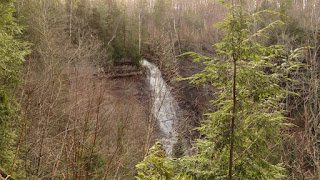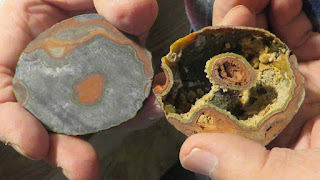It has been quite some time since I was able to go on a long hike. Yesterday was the day. Friends, Helen and Lois, and I drove into Chapel Parking, located several miles north of Melstrand. It was not a surprise that we were the only people hiking. We didn't see any other vehicles or people. Temperatures were in the mid-30s and it was partly cloudy. Although we originally hoped to do the entire loop, the early sunset this time of year did not give us enough time. Thus, we hiked past Chapel Falls to Chapel Rock, and then back along the west side of Chapel Lake. In total the distance was 6.5 miles.
Today I will post the first half of the photos; tomorrow I'll post the rest.
Heading down the trail 3.5 miles to the connecting trail along the west side of Chapel Beach.
Chapel Falls....
The number of downed trees was intense. Some of the down trees are due to pathogens that have attacked and killed the beach trees as well as some of the white birch. Others were due to the incredible wind storms we have had this year.
Chapel Rock with the surviving tree on top....
Grand Portal Point...
Chapel Beach, which is a lot shallower than it used to be due to erosion.
Thursday, November 30, 2017
Tuesday, November 28, 2017
Presque Isle Deer and more
After the Wisconsin trip, I had a short turnaround to prepare for Starry, Starry Night (Grand Marais' Black Friday shopping event), before I headed to the Keewenaw for Thanksgiving. Thanks to my son's in-laws for allowing me to participate in the festivities.
At the end of the Wisconsin trip, I stayed with friends in Marquette before speaking at the Ishpeming rock club meeting. Thanks to Jimmy and Helen for your incredible hospitality. Also, thanks to Helen for the play on Saturday night, and for the hike we had on Presque Isle. We went on the hike for exercise, but also to check out the erosion from recent wind events. There was considerable erosion.
In October during the "big storm," the island was closed to all traffic. Some people walked around the barriers to check out the waves. Unfortunately, several people got too close and were swept off the rocks. Two didn't make it. I'm not sure where on the black rocks they were, but here is the general area.
The ice along the shoreline was coating everything.
During the hike we saw a huge buck as well as a smaller doe.
For the most part my traveling is done for the winter. I have started the research on my next book, which will be the second in the Rocks through Time series. This one will be about the geologic history of the Great Lakes and will describe how the lakes formed. I still have to do a web page update and make some custom mineral art, but work on the book will ramp up soon. I am excited.
At the end of the Wisconsin trip, I stayed with friends in Marquette before speaking at the Ishpeming rock club meeting. Thanks to Jimmy and Helen for your incredible hospitality. Also, thanks to Helen for the play on Saturday night, and for the hike we had on Presque Isle. We went on the hike for exercise, but also to check out the erosion from recent wind events. There was considerable erosion.
In October during the "big storm," the island was closed to all traffic. Some people walked around the barriers to check out the waves. Unfortunately, several people got too close and were swept off the rocks. Two didn't make it. I'm not sure where on the black rocks they were, but here is the general area.
The ice along the shoreline was coating everything.
During the hike we saw a huge buck as well as a smaller doe.
For the most part my traveling is done for the winter. I have started the research on my next book, which will be the second in the Rocks through Time series. This one will be about the geologic history of the Great Lakes and will describe how the lakes formed. I still have to do a web page update and make some custom mineral art, but work on the book will ramp up soon. I am excited.
Tuesday, November 21, 2017
All About Cheese
While in Wisconsin we stopped by the Wisconsin Diary State Cheese Company. I started thinking about what cheese really is, so I decided to do a blog post on the subject.
Cheese is a food made from milk that is produced worldwide in a variety of flavors and textures. It is made by coagulating the protein in milk called casein. Although most cheese is made from the milk of cows, it can also be made with the milk of buffalo, goats, and sheep. During production coagulation is stimulated by adding the enzyme rennet, after which the solids are separated and pressed into final form.
The varieties of cheese differ depending on the type of milk used, the diet of the animals, the butterfat content of the milk, the inclusion of bacteria or mold, the processing and aging of the cheese, the addition of herbs or spices, and whether the cheese is pasteurized. Cheese is valued for its portability, long shelf life, and high content of fat, protein, calcium, and phosphorus.
Cheese is an ancient food with an origins that predates recorded history. There is no conclusive evidence indicating where cheesemaking originated, but the practice of making cheese was well established well before Roman times and possibly as early as 8,000 b.c.
The first factory for the industrial production of cheese opened in Switzerland in 1815, but large-scale production first found real success in the United States. Credit usually goes to Jesse Williams, a dairy farmer from Rome, New York, who in 1851 started making cheese in an assembly-line fashion using the milk from neighboring farms.
Around 20 tonnes of cheese is manufactured worldwide, with U.S. production equaling around one-third. Around 25 percent of U.S. production is in Wisconsin. The highest consumption per person takes place in France, Iceland, Finland, Denmark and Germany.
The variety of components can be extreme. Some common cheese components are below.
Cheese is a food made from milk that is produced worldwide in a variety of flavors and textures. It is made by coagulating the protein in milk called casein. Although most cheese is made from the milk of cows, it can also be made with the milk of buffalo, goats, and sheep. During production coagulation is stimulated by adding the enzyme rennet, after which the solids are separated and pressed into final form.
The varieties of cheese differ depending on the type of milk used, the diet of the animals, the butterfat content of the milk, the inclusion of bacteria or mold, the processing and aging of the cheese, the addition of herbs or spices, and whether the cheese is pasteurized. Cheese is valued for its portability, long shelf life, and high content of fat, protein, calcium, and phosphorus.
Cheese is an ancient food with an origins that predates recorded history. There is no conclusive evidence indicating where cheesemaking originated, but the practice of making cheese was well established well before Roman times and possibly as early as 8,000 b.c.
The first factory for the industrial production of cheese opened in Switzerland in 1815, but large-scale production first found real success in the United States. Credit usually goes to Jesse Williams, a dairy farmer from Rome, New York, who in 1851 started making cheese in an assembly-line fashion using the milk from neighboring farms.
Around 20 tonnes of cheese is manufactured worldwide, with U.S. production equaling around one-third. Around 25 percent of U.S. production is in Wisconsin. The highest consumption per person takes place in France, Iceland, Finland, Denmark and Germany.
The variety of components can be extreme. Some common cheese components are below.
| Cheese | Water | Protein | Fat | Carbs |
|---|---|---|---|---|
| Swiss | 37.1 | 26.9 | 27.8 | 5.4 |
| Feta | 55.2 | 14.2 | 21.3 | 4.1 |
| Cheddar | 36.8 | 24.9 | 33.1 | 1.3 |
| Mozarella | 50 | 22.2 | 22.4 | 2.2 |
| Cottage | 80 | 11.1 | 4.3 | 3.4 |
Monday, November 20, 2017
Wisconsin Agate Collectin Crawl
Thanks to Doug and Susan Moore for their hospitality last week. Special thanks to Doug for organizing an agate collection tour for Sharon Smith and I. We spent two days visiting rockhounds to see their incredible collections. What fun! Here are a few photos.
Every day you learn something new. I had no idea there is a "subculture" of sand collectors. One of the people we visited had 800 sand samples from all over the world. It is amazing how different the sand varieties are in terms of color, texture, and mineral composition.
Dry head agate....
Incredible tube agate...
Weird agate...
Dino bone....
Nice agate that formed in rhyolitic matrix. I don't remember for sure, but I think this specimen is Mexican.
Lake Superior thunder egg.
Mexican Laguna agate.
This is an awesome map created by one of Doug's friends. It shows the hot spots resulting from plate tectonic movement -- which resulted in the creation of many agates and jaspers.
Fairburn agates...
Cool agate (I don't remember from where).
Laker...
Priday agate from Oregon.
Interesting Montana moss agate...
This agate was infilled with calcite. Acids were used to remove the calcite from the half on the right.
Tube agate...
Fairburn agate from South Dakota...
Every day you learn something new. I had no idea there is a "subculture" of sand collectors. One of the people we visited had 800 sand samples from all over the world. It is amazing how different the sand varieties are in terms of color, texture, and mineral composition.
Dry head agate....
Incredible tube agate...
Weird agate...
Dino bone....
Nice agate that formed in rhyolitic matrix. I don't remember for sure, but I think this specimen is Mexican.
Lake Superior thunder egg.
Mexican Laguna agate.
This is an awesome map created by one of Doug's friends. It shows the hot spots resulting from plate tectonic movement -- which resulted in the creation of many agates and jaspers.
Fairburn agates...
Cool agate (I don't remember from where).
Laker...
Priday agate from Oregon.
Interesting Montana moss agate...
This agate was infilled with calcite. Acids were used to remove the calcite from the half on the right.
Tube agate...
Fairburn agate from South Dakota...
Subscribe to:
Posts (Atom)



















































